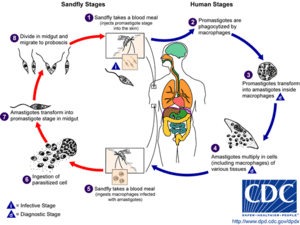Visceral Leishmaniasis (Kala azar)
From MicrobeWiki, the student-edited microbiology resource

University of Oklahoma Study Abroad Microbiology in Arezzo, Italy[1]

(from left to right) The sandfly vector, gram stain of a blood meal, and the last image is of Leishmaniasis promastigotes from a culture. From: CDC.com [2]
Etiology/Bacteriology
Taxonomy
Description
Pathogenesis
Transmission/Reservoirs

The pathogenesis of visceral leishmaniasis. From: CDC.com [3]
Incubation/Colonization
Epidemiology
Virulence Factors
Clinical Features
Diagnosis
In order to diagnosis visceral leishmaniasis, a sample from bone marrow of the infected patient is necessary. The bone marrow then can be examined under a microscope or in special cultures. Another way visceral leishmaniasis can be detected is through a blood test. This type of test can detect antibodies that the host immune system makes to defend itself against the pathogen. A quick way to detect visceral leishmaniasis is by polymerase chain reaction (PCR). Other ways of detecting visceral leishmaniasis by coagulation studies, liver function test, and peripheral blood smears. (http://emedicine.medscape.com/article/220298-overview)
Treatment
Prevention
Host Immune Response
References
Created by Taylor Caswell Student of Dr. Tyrrell Conway, University of Oklahoma
